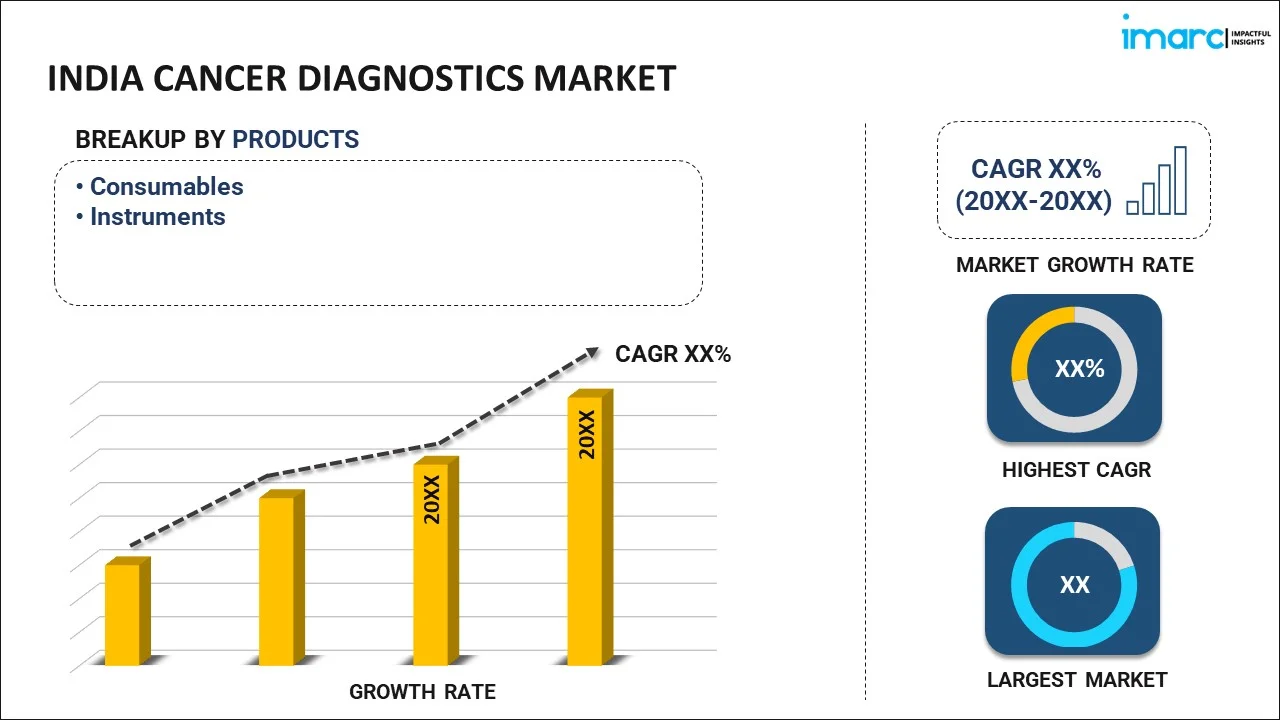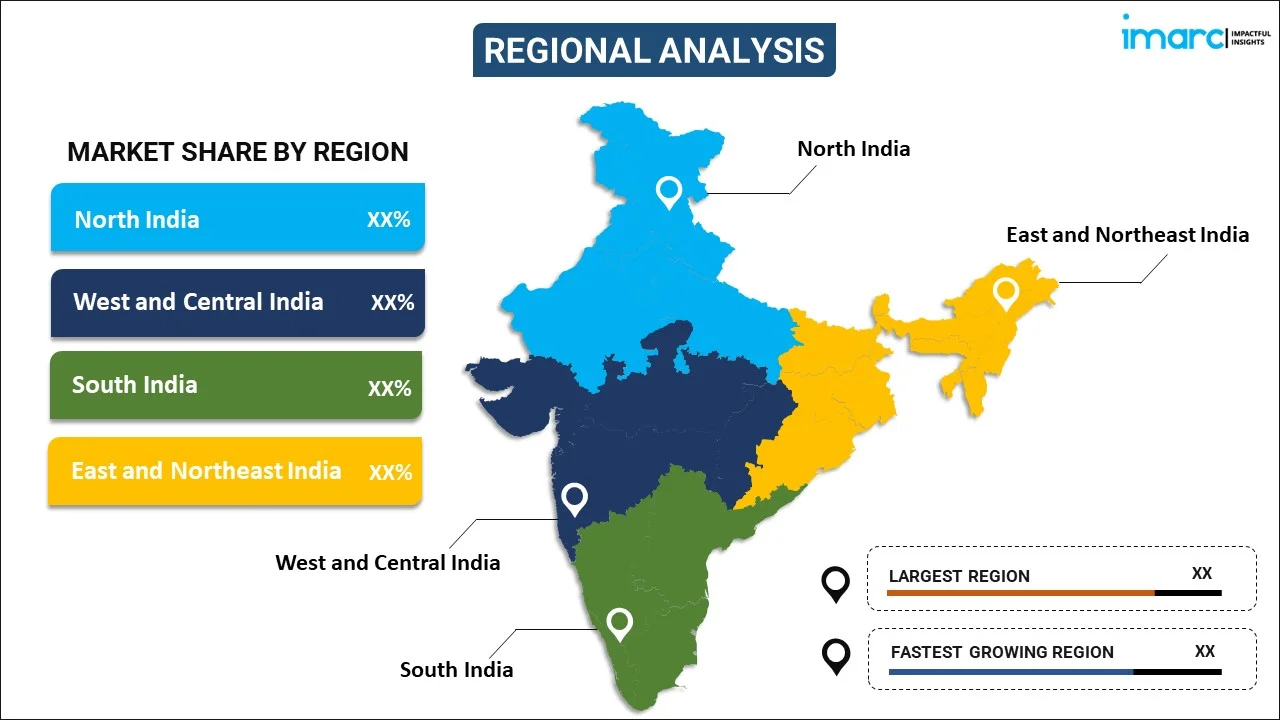
India Cancer Diagnostics Market Report by Product (Consumables, Instruments), Technology (IVD Testing, Imaging, Biopsy Technique), Application (Breast Cancer, Lung Cancer, Colorectal Cancer, Melanoma, and Others), End User (Hospitals and Clinics, Diagnostic Laboratories, and Others), and Region 2025-2033
Market Overview:
India cancer diagnostics market size reached USD 7.3 Billion in 2024. Looking forward, IMARC Group expects the market to reach USD 14.2 Billion by 2033, exhibiting a growth rate (CAGR) of 7.13% during 2025-2033. The ongoing advancements in diagnostic technologies, such as molecular diagnostics, next-generation sequencing, and liquid biopsy, which have improved the accuracy and efficiency of cancer diagnostics, are driving the market.
|
Report Attribute
|
Key Statistics
|
|---|---|
|
Base Year
|
2024 |
|
Forecast Years
|
2025-2033
|
|
Historical Years
|
2019-2024
|
| Market Size in 2024 | USD 7.3 Billion |
| Market Forecast in 2033 | USD 14.2 Billion |
| Market Growth Rate (2025-2033) | 7.13% |
Cancer diagnostics is the process of identifying and determining the presence of cancer in an individual. It involves a series of tests and procedures designed to detect abnormal cells or tumors within the body. Common diagnostic methods include imaging techniques such as X-rays, CT scans, and MRIs, as well as laboratory tests like blood tests and biopsies. Molecular and genetic testing may also be employed to analyze the specific characteristics of cancer cells, helping to guide treatment decisions. Early and accurate cancer diagnostics are crucial for timely intervention and effective treatment, as early-stage detection often leads to better outcomes. Advances in medical technology and research have contributed to the development of more sophisticated and precise diagnostic tools, improving the ability to identify various types of cancers and understand their unique characteristics. The field continues to evolve, with ongoing efforts to enhance diagnostic accuracy and accessibility, ultimately contributing to improved patient outcomes and a better understanding of cancer biology.
India Cancer Diagnostics Market Trends:
The cancer diagnostics market in India is witnessing substantial growth, propelled by various drivers that collectively contribute to its expansion. Firstly, the escalating prevalence of cancer regionally serves as a primary catalyst for the increasing demand for diagnostic tools and technologies. Additionally, advancements in medical research and technology have ushered in innovative diagnostic methodologies, fostering early detection and precise diagnosis of various cancer types. Moreover, the rising awareness among individuals regarding the importance of regular screenings and check-ups further fuels the demand for cancer diagnostics. Furthermore, collaborative efforts between pharmaceutical companies and diagnostic laboratories are driving the development of cutting-edge diagnostic solutions, enhancing the overall efficiency and accuracy of cancer diagnostics. In tandem, the growing elderly population, which is more susceptible to cancer, contributes significantly to market growth. The integration of artificial intelligence and machine learning in diagnostic processes also plays a pivotal role in refining diagnostic capabilities. Altogether, these interconnected factors create a robust landscape for the cancer diagnostics market in India, ensuring sustained growth and an improved outlook for cancer patients.
India Cancer Diagnostics Market Segmentation:
IMARC Group provides an analysis of the key trends in each segment of the market, along with forecasts at the country level for 2025-2033. Our report has categorized the market based on product, technology, application, and end user.
Product Insights:

- Consumables
- Antibodies
- Kits and Reagents
- Probes
- Others
- Instruments
- Pathology-based Instruments
- Imaging Instruments
- Biopsy Instruments
The report has provided a detailed breakup and analysis of the market based on the product. This includes consumables (antibodies, kits and reagents, probes, and others) and instruments (pathology-based instruments, imaging instruments, and biopsy instruments).
Technology Insights:
- IVD Testing
- Polymerase Chain Reaction (PCR)
- In Situ Hybridization (ISH)
- Immunohistochemistry (IHC)
- Next-generation Sequencing (NGS)
- Microarrays
- Flow Cytometry
- Immunoassays
- Others
- Imaging
- Magnetic Resonance Imaging (MRI)
- Computed Tomography (CT)
- Positron Emission Tomography (PET)
- Mammography
- Ultrasound
- Biopsy Technique
A detailed breakup and analysis of the market based on the technology have also been provided in the report. This includes IVD testing (polymerase chain reaction (PCR), in situ hybridization (ISH), immunohistochemistry (IHC), next-generation sequencing (NGS), microarrays, flow cytometry, immunoassays, and others), imaging (magnetic resonance imaging (MRI), computed tomography (CT), positron emission tomography (PET), mammography, and ultrasound), and biopsy technique.
Application Insights:
- Breast Cancer
- Lung Cancer
- Colorectal Cancer
- Melanoma
- Others
The report has provided a detailed breakup and analysis of the market based on the application. This includes breast cancer, lung cancer, colorectal cancer, melanoma, and others.
End User Insights:
- Hospitals and Clinics
- Diagnostic Laboratories
- Others
A detailed breakup and analysis of the market based on the end user have also been provided in the report. This includes hospitals and clinics, diagnostic laboratories, and others.
Regional Insights:

- North India
- West and Central India
- South India
- East and Northeast India
The report has also provided a comprehensive analysis of all the major regional markets, which include North India, West and Central India, South India, and East and Northeast India.
Competitive Landscape:
The market research report has also provided a comprehensive analysis of the competitive landscape in the market. Competitive analysis such as market structure, key player positioning, top winning strategies, competitive dashboard, and company evaluation quadrant has been covered in the report. Also, detailed profiles of all major companies have been provided.
India Cancer Diagnostics Market Report Coverage:
| Report Features | Details |
|---|---|
| Base Year of the Analysis | 2024 |
| Historical Period | 2019-2024 |
| Forecast Period | 2025-2033 |
| Units | Billion USD |
| Scope of the Report | Exploration of Historical Trends and Market Outlook, Industry Catalysts and Challenges, Segment-Wise Historical and Future Market Assessment:
|
| Products Covered |
|
| Technologies Covered |
|
| Applications Covered | Breast Cancer, Lung Cancer, Colorectal Cancer, Melanoma, Others |
| End Users Covered | Hospitals and Clinics, Diagnostic Laboratories, Others |
| Regions Covered | North India, West and Central India, South India, East and Northeast India |
| Customization Scope | 10% Free Customization |
| Post-Sale Analyst Support | 10-12 Weeks |
| Delivery Format | PDF and Excel through Email (We can also provide the editable version of the report in PPT/Word format on special request) |
Key Questions Answered in This Report:
- How has the India cancer diagnostics market performed so far and how will it perform in the coming years?
- What has been the impact of COVID-19 on the India cancer diagnostics market?
- What is the breakup of the India cancer diagnostics market on the basis of product?
- What is the breakup of the India cancer diagnostics market on the basis of technology?
- What is the breakup of the India cancer diagnostics market on the basis of application?
- What is the breakup of the India cancer diagnostics market on the basis of end user?
- What are the various stages in the value chain of the India cancer diagnostics market?
- What are the key driving factors and challenges in the India cancer diagnostics?
- What is the structure of the India cancer diagnostics market and who are the key players?
- What is the degree of competition in the India cancer diagnostics market?
Key Benefits for Stakeholders:
- IMARC’s industry report offers a comprehensive quantitative analysis of various market segments, historical and current market trends, market forecasts, and dynamics of the India cancer diagnostics market from 2019-2033.
- The research report provides the latest information on the market drivers, challenges, and opportunities in the India cancer diagnostics market.
- Porter's five forces analysis assist stakeholders in assessing the impact of new entrants, competitive rivalry, supplier power, buyer power, and the threat of substitution. It helps stakeholders to analyze the level of competition within the India cancer diagnostics industry and its attractiveness.
- Competitive landscape allows stakeholders to understand their competitive environment and provides an insight into the current positions of key players in the market.
Need more help?
- Speak to our experienced analysts for insights on the current market scenarios.
- Include additional segments and countries to customize the report as per your requirement.
- Gain an unparalleled competitive advantage in your domain by understanding how to utilize the report and positively impacting your operations and revenue.
- For further assistance, please connect with our analysts.
 Inquire Before Buying
Inquire Before Buying
 Speak to an Analyst
Speak to an Analyst
 Request Brochure
Request Brochure
 Request Customization
Request Customization




.webp)




.webp)












